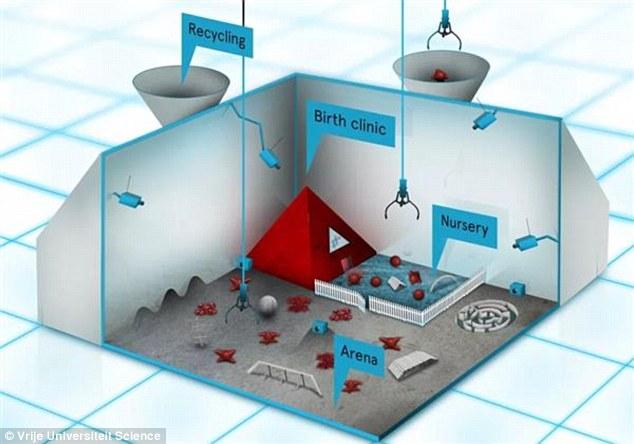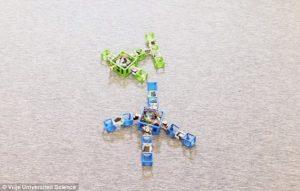“…And a robot is born.”
 Remember that part of your heart reserved solely for fluffy kitties, furry puppies, and sleepy hedgehogs? Tell everyone to scooch over—that’s right—and make some room up in there for cooing baby robots. They might one day require sufficient adulation through social media memes as well, although surely their parents’ motherboards will be swelling with pride every time they take a break from work to look over at the little guys.
Remember that part of your heart reserved solely for fluffy kitties, furry puppies, and sleepy hedgehogs? Tell everyone to scooch over—that’s right—and make some room up in there for cooing baby robots. They might one day require sufficient adulation through social media memes as well, although surely their parents’ motherboards will be swelling with pride every time they take a break from work to look over at the little guys.
And how you may ask, are these babies made? Don’t be silly! It’s all quite normal. Two robots meet at a hip place for drinks and they really hit it off, one computation leads to another, and soon they find themselves engineering a child and decorating a well-appointed nursery together. And where is this all this rather unwieldy intimacy happening? Why, Amsterdam of course.
You may have an eyebrow raised at this point, but really, it’s not that these Dutch researchers have a thing for kinky robot porn. And, no, it’s not about cuddling chubby little mechanical offspring. These ‘families’ are being created for serious work—the kind that humans might find a lot to complain about over a late dinner together as they grip their aching backs and rest their blistered feet.
 Robots though? They rarely screw up. They don’t bitch and whine, need to take sick days, or even mind working in dark, toxic conditions as a foreman cracks the whip endlessly. And so scientists at Vrije Universiteit Amsterdam, also known as evolutionary biologists, are working to make lots of these hardy creatures with the Robot Baby Project. They’ve already had success with their first nuclear family of bots too, which they had a chance to show off proudly at a campus party in the Jaarbeurs in Utrecht just recently. And it must have been with great interest that those attending were able to see exactly how mating occurs for these couples.
Robots though? They rarely screw up. They don’t bitch and whine, need to take sick days, or even mind working in dark, toxic conditions as a foreman cracks the whip endlessly. And so scientists at Vrije Universiteit Amsterdam, also known as evolutionary biologists, are working to make lots of these hardy creatures with the Robot Baby Project. They’ve already had success with their first nuclear family of bots too, which they had a chance to show off proudly at a campus party in the Jaarbeurs in Utrecht just recently. And it must have been with great interest that those attending were able to see exactly how mating occurs for these couples.
“We have two robots that meet and mate, and just as in the animal kingdom, this results in a baby,” says Guszti Eiben, Professor of Artificial Intelligence at VU, in a video explaining the concept.
It’s unprecedented, with research revolving around artificial sex, offspring, and streamlined evolution. The scientists foresee the robots making ‘children’ that with each generation are better, stronger, and more advanced in physicality, behavior, and intelligence. And the idea isn’t for them to be building robot ‘burbs and working cushy desk jobs. These robust resources will be able to do all those things we can’t, like working in hazardous environments, and perhaps those that are far away, in space or even deep sea mines.
 Living conditions might not be up to Barbie and Ken’s standards, but the bots will feasibly work, hang out together, and then go to an area called the ‘arena,’ where they are able to select suitable mates, communicate, and have sex. They learn and they are motivated.
Living conditions might not be up to Barbie and Ken’s standards, but the bots will feasibly work, hang out together, and then go to an area called the ‘arena,’ where they are able to select suitable mates, communicate, and have sex. They learn and they are motivated.
In this case, the scientists have given them incentive to walk toward a red light, as that is basically the meeting place, and where mating occurs. There is apparently some choice involved too, as the robots ‘evaluate’ each other (now there’s an interesting idea—what are a robot’s likes and dislikes? Dealbreakers?). If there is indeed a match, intercourse basically occurs in a very sophisticated online manner:
“When they evaluate each other favorably, they send their genomes through the Wi-Fi network,” says Milan Jelisavcic, a PhD student at the university. “A sexual reproduction mechanism then creates the new genome.”
The genome, or code, is sent off to the 3D printer where the ‘baby’ is actually made and then accentuated with software and other hardware. The researchers like to think of this as not the new industrial revolution, but rather evolution. This could be the key to finally bringing many sci-fi concepts we’ve been enjoying at the movie theater into reality, like colonizing other planets such as Mars—a subject we discuss quite regularly, from 3D printed space rovers to ideas for feasible 3D printed habitats to support us in living there—with robots tending to figure into the equation prominently.
“With evolutionary techniques, we evolve the neural networks of the robots,’ explains Jacqueline Heinerman, PhD student. “These neural networks are responsible for their behaviors.”
The robot babies are actually born in birth clinics and then are transferred to nurseries. Like any other new beings, they must immediately begin learning; however, this isn’t all fun and games. Take a look at the accompanying image. See the recycling bin? If these kids don’t measure up through learned ‘fitness functions’, that’s where they go without any chance to reproduce. If they are, however, up to snuff, then they get to become part of this newfangled robot society and will eventually be parents as well, passing on their superior DNA.
“Evolution is a great designer,” says Eiben. “The Evolution of Things is an emerging new technology that exploits the power of selection and reproduction to breed robot designs that are hard to obtain by traditional approaches. Robots that evolve can adapt to their environment and cope with unforeseen situations.”
“The bodies, brains, and behaviors are continually tested by the environment and the useful traits are amplified in future generations. This technology opens new perspectives for robotics, artificial intelligence, space research, and even biology.”
Currently this is, as Eiben points out, a proof of concept. Eventually though, human hands may need not play a part here even as the machines will be sufficiently programmed and smart enough to work, play, and make babies on their own, operating in a culture parallel to ours. Do you see all of this becoming a reality? Discuss further in the 3D Printed Robots Procreate forum over at 3DPB.com.
[Source: Daily Mail / Images: Vrije Universiteit Science]
Check out the video below to understand more about exactly what these scientists are up to:
Subscribe to Our Email Newsletter
Stay up-to-date on all the latest news from the 3D printing industry and receive information and offers from third party vendors.
Print Services
Upload your 3D Models and get them printed quickly and efficiently.
You May Also Like
3D Printing News Briefs, July 2, 2025: Copper Alloys, Defense Manufacturing, & More
We’re starting off with metals in today’s 3D Printing News Briefs, as Farsoon has unveiled a large-scale AM solution for copper alloys, and Meltio used its wire-laser metal solution to...
3DPOD 260: John Hart on VulcanForms, MIT, Desktop Metal and More
John Hart is a Professor at MIT; he´s also the director of the Laboratory for Manufacturing and Productivity as well as the director of the Center for Advanced Production Technologies....
3D Printing News Briefs, June 28, 2025: Defense Accelerator, Surgical Models, & More
In this weekend’s 3D Printing News Briefs, 3YOURMIND was selected to join an EU Defense Accelerator, and PTC has announced model-based definition (MBD) capabilities within Onshape. Finally, a study out...
EOS in India: AM’s Rising Star
EOS is doubling down on India. With a growing base of aerospace startups, new government policies, and a massive engineering workforce, India is quickly becoming one of the most important...




































